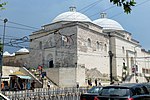Vezneciler (Istanbul Metro)

Vezneciler is a station on the M2 line of the Istanbul Metro. The station is located under Şehzadebaşı Street and 16 Mart Şehitleri Street in the historical Fatih district of Istanbul. Opened on 16 March 2014, Vezneciler is the most recently opened station on the M2 line. At 30m below ground level, it is the deepest station of the Istanbul Metro. During the inauguration the station was dedicated to Ottoman police officers who were killed during a conflict with British forces during the Occupation of Constantinople in 1920. Istanbul University's main campus, Beyazıt Square and the Şehzade Mosque are a few landmarks in the vicinity of the station. On 7 June 2016, a bomb reportedly targeting a police bus struck around this station.
Excerpt from the Wikipedia article Vezneciler (Istanbul Metro) (License: CC BY-SA 3.0, Authors, Images).Vezneciler (Istanbul Metro)
16 Mart Şehitleri Caddesi, Istanbul
Geographical coordinates (GPS) Address Nearby Places Show on map
Geographical coordinates (GPS)
| Latitude | Longitude |
|---|---|
| N 41.0124 ° | E 28.9595 ° |
Address
Padişah Pilavcısı
16 Mart Şehitleri Caddesi
34134 Istanbul
Türkiye
Open on Google Maps








